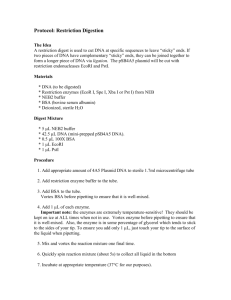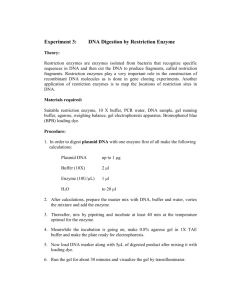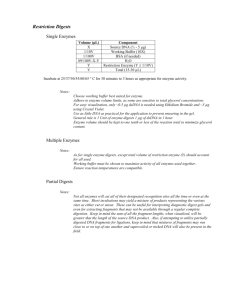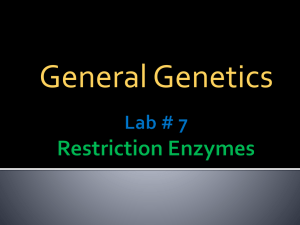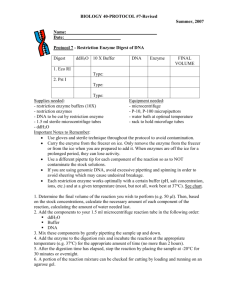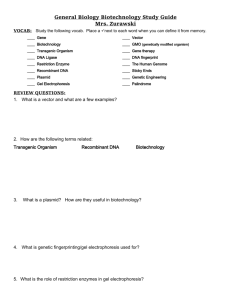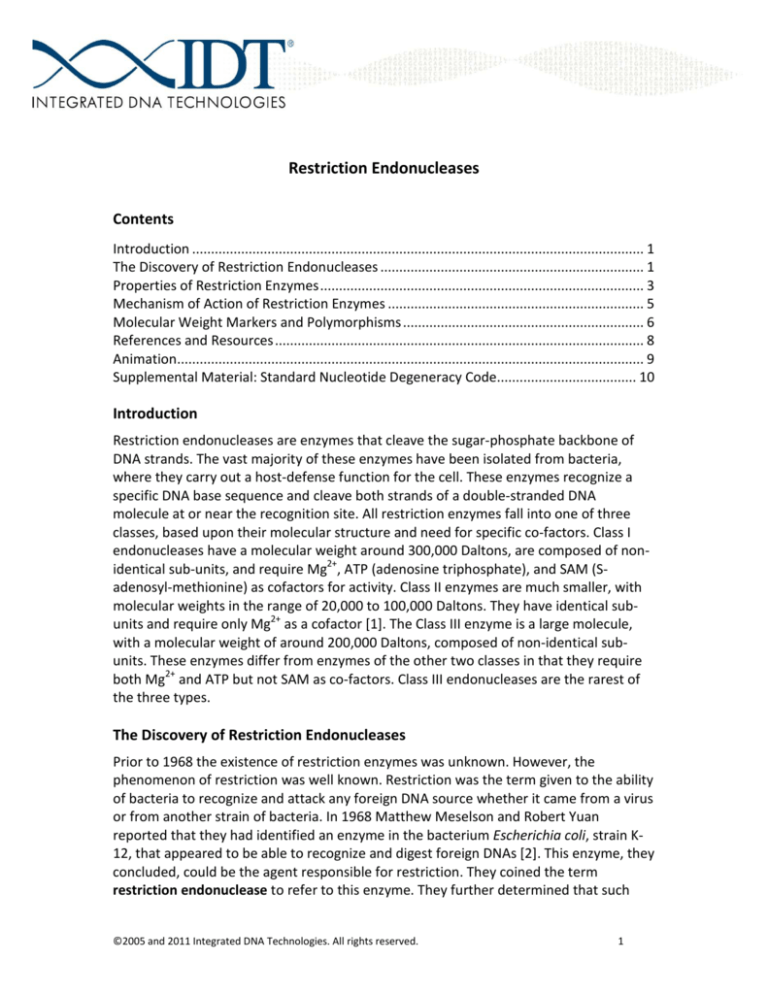
Restriction Endonucleases
Contents
Introduction ........................................................................................................................ 1
The Discovery of Restriction Endonucleases ...................................................................... 1
Properties of Restriction Enzymes ...................................................................................... 3
Mechanism of Action of Restriction Enzymes .................................................................... 5
Molecular Weight Markers and Polymorphisms ................................................................ 6
References and Resources .................................................................................................. 8
Animation............................................................................................................................ 9
Supplemental Material: Standard Nucleotide Degeneracy Code..................................... 10
Introduction
Restriction endonucleases are enzymes that cleave the sugar-phosphate backbone of
DNA strands. The vast majority of these enzymes have been isolated from bacteria,
where they carry out a host-defense function for the cell. These enzymes recognize a
specific DNA base sequence and cleave both strands of a double-stranded DNA
molecule at or near the recognition site. All restriction enzymes fall into one of three
classes, based upon their molecular structure and need for specific co-factors. Class I
endonucleases have a molecular weight around 300,000 Daltons, are composed of nonidentical sub-units, and require Mg2+, ATP (adenosine triphosphate), and SAM (Sadenosyl-methionine) as cofactors for activity. Class II enzymes are much smaller, with
molecular weights in the range of 20,000 to 100,000 Daltons. They have identical subunits and require only Mg2+ as a cofactor [1]. The Class III enzyme is a large molecule,
with a molecular weight of around 200,000 Daltons, composed of non-identical subunits. These enzymes differ from enzymes of the other two classes in that they require
both Mg2+ and ATP but not SAM as co-factors. Class III endonucleases are the rarest of
the three types.
The Discovery of Restriction Endonucleases
Prior to 1968 the existence of restriction enzymes was unknown. However, the
phenomenon of restriction was well known. Restriction was the term given to the ability
of bacteria to recognize and attack any foreign DNA source whether it came from a virus
or from another strain of bacteria. In 1968 Matthew Meselson and Robert Yuan
reported that they had identified an enzyme in the bacterium Escherichia coli, strain K12, that appeared to be able to recognize and digest foreign DNAs [2]. This enzyme, they
concluded, could be the agent responsible for restriction. They coined the term
restriction endonuclease to refer to this enzyme. They further determined that such
©2005 and 2011 Integrated DNA Technologies. All rights reserved.
1
enzymes would be ubiquitous among bacteria and that they would recognize and digest
any double-stranded DNA that was not protected by a specific pattern of DNA base
methylation [2]. Methylation of DNA involves adding a methyl-group (CH3) to the DNA
base such that the restriction enzyme will not recognize it. The process of methylation
has been shown to be carried out by DNA sequence-specific methyltransferase enzymes
[3, 4]. In plants and animals the primary methylated base is 5-methylcytosine (m5C)
while in bacteria the major methylated base is N6-methyladenine (mA) but N4methylcytosine (mC) is also found. Examples of these methylated DNA bases are shown
in Figure 1. The restriction endonucleases found by Meselson and Yuan in E. coli
required the presence of Mg2+, SAM, and ATP for it to carry out its function. Thus, the
first restriction enzyme to be identified was a Class I enzyme.
Figure 1. Structures of the three primary methylated DNA bases in prokaryotes and
eukaryotes.
The report by Meselson and Yuan was quickly followed by two papers describing a
similar enzyme in the bacterium Haemophilus influenzae, strain Rd [5, 6]. Like the E. coli
enzyme, the H. influenzae endonucleases was inactive in the presence of native DNA but
did recognize and digest foreign DNAs. Unlike the E. coli enzyme, however, the H.
influenzae endonuclease only required the presence of Mg2+ for activity. The cleavage
pattern of both enzymes was limited and consistently reproducible, suggesting that
there was a specific DNA sequence that was recognized by the enzymes and that the
enzyme would bind to this sequence prior to cleavage [6]. In the companion paper, Kelly
and Smith offered evidence that the recognition site of their enzyme was a run of six
specific nucleotides in the form,
5’… G T Py | Pu A C … 3’
3’… C A Pu | Py T G … 5’
where Py refers to either pyrimidine (T or C), Pu refers to either purine (A or G), and the
vertical line indicates the cleavage site of the enzyme. Note that the symmetry of this
recognition sequence is in the form of a palindrome, a nucleotide sequence in which the 5’
to 3’ sequence of one strand of a segment of DNA is the same as that of its complementary
strand. This feature did not escape notice, “It is unlikely that the symmetry of this
sequence is fortuitous, since the number of possible asymmetric sequences of this type
©2005 and 2011 Integrated DNA Technologies. All rights reserved.
2
is about 30 times the number of possible symmetric sequences…” [5]. They concluded
that symmetry in the recognition sequence was a basic feature of the action of the
enzyme.
Properties of Restriction Enzymes
Within a few years the basic outlines of restriction endonuclease action were
understood. The seminal papers of 1968 and 1970 opened the floodgates on isolation
and identification of restriction enzymes in bacteria. In 1975, Nathans and Smith were
able to review the state of knowledge and present a consistent, standard nomenclature
for the rapidly growing numbers of known enzymes. The name given to each new
enzyme would convey both the genus and the species of the bacterium from which it
was isolated, the strain number, and the order in series in which the enzyme was found.
Thus, the restriction enzyme designated Bam HI was the first enzyme found in the
bacterium Bacillus amyloliquifaciens, strain H while the restriction enzyme Hae III was
the third enzyme found in Haemophilus aegyptius. A list of some of the thousands of
currently known restriction endonucleases is presented in Table 1. As the list of
restriction enzymes grew and their recognition sequences were identified, it was found
in some cases that more than one enzyme could recognize the same sequence. RJ
Roberts conferred the term isoschizomer (same cutter) on restriction enzymes that
recognized the same DNA sequence [1].
The search for new and unusual restriction enzymes continued apace so that, by 1982, a
list of 357 identified restriction enzymes recognizing 90 different DNA sequences was
published [7]. Most restriction enzyme recognition sequences are from four to eight
bases long and most are palindromic (Table 1). Additional diversity was found among
the isoschizomers. For example, the enzymes Sma I and Xma I both recognize the six
base sequence CCCGGG but give different fragments with the former cutting CCC|GGG
and the latter cutting C|CCGGG. Similarly, the isoschizomeric pair Hha I and Hin PI both
recognize the sequence GCGC but the former cuts GCG|C and the latter G|CGC. Further
differences were found in relation to sensitivity to methylation. Both Mbo I and Sau 3A
cut GA|TC but when the sequence is methylated as GA*TC, Mbo I fails to cut while Sau
3A is not affected. Conversely, in the case GATC*, the situation is reversed. This
phenomenon was put to good use in the case of the restriction enzyme pair Hpa II and
Msp I. Both enzymes recognize the sequence CCGG but when methylated as CC*GG,
Mbo I cuts the sequence and Hpa II does not. This pair of enzymes has proved to be
extremely useful in identification of the so-called cpG “islands” that lie near protein
coding genes [8, 9].
©2005 and 2011 Integrated DNA Technologies. All rights reserved.
3
Table 1
Examples of Restriction Enzymes
Enzyme
Alu I
Apa I
Bam HI
Bgl II
Cla I
Dde I
Dra I
Eco RI
Eco RV
Fnu4H I
Hae III
Hind II
Hinf I
Kpn I
Mbo I
Msp I
Nde I
Not I
Pst I
Pvu II
Rsa I
Sma I
Taq I
Xba I
Xho I
Microorganism
Recognition Sequence
Arthrobacter luteus
Acetobacter pasteurianus
Bacillus amiloliquifaciens
Bacillus globigii
Caryophanon latum L
Desulfovibrio desulfuricans
Deinococcus radiophilus
Escherichia coli RY13
Escherichia coli J62
Fusobacterium nucleatum 4H
Haemophilus aegyptius
Haemophilus influenzae Rd
Haemophilus influenzae Rf
Klebsiella pnumoniae OK8
Moraxella bovis
Morazella sp.
Neisseria dentrificans
Nocardia otitidis-caviarum
Providencia stuartii 164
Proteus vulgaris
Rhodopseudomonas sphaeroides
Serratio marcescens S
Thermus aquaticus YT1
Xanthomonas badrii
Xanthomonas holcicola
Isoschizomers
AG|CT
GGGCC|C
Bsp120 I, PspOM I
G|GATCC
A|GATCT
AT|CGAT
Bsp DI, Bsc I, BspX I
C|TNAG
BstDE I
TTT|AAA
G|AATTC
GAT|ATC
Eco32 I
GC|NGC
Fsp4H I, Ita I
GG|CC
Bsh I, BsuR I, Pal I
A|AGCTT
G|ANTC
GGTAC|C
Acc65 I, Asp718 I
|GATC
Dpn II, Nde II, Sau3A I
C|CGG
BsiS I, Hap II, Hpa II
CA|TATG
FauND I
GC|GGCCGC
CciN I
CTGCA|G
CAG|CTG
GT|AC
CCC|GGG
Cfr9 I, Psp A I, Xma I
T|CGA
TtaHB8 I
T|CTAGA
C|TCGAG PaeR7 I, Sfr274 I, Tli I
As can be seen in Table 1, most restriction enzymes recognize CG-rich DNA sequences
but some AT-only recognition sequences are known. The enzymes Dra I (TTTAAA), Ssp I
(AATATT), and Pac I (TTAATTAA) are but three of these “AT-cutters.” Further, most
restriction enzymes will cleave the DNA inside the recognition site but there are several
that do not. The enzyme Mnl I recognizes the non-palindromic sequence CCTC but
cleaves the DNA seven bases downstream (i.e., CCTC 7/7). Other examples include Bbv I
(GCAGC 8/12) and Hga I (GACGC 5/10). Another variation on the basic theme of
restriction enzyme recognition sites are the so-called “degenerate” sequences. The
enzyme Acc I recognizes the sequences GTATAC and GTCGAC. This can also be written as
GTMKAC, referring to the standard nomenclature for degenerate sites (see
Supplemental Materials). The five-base cutter Hinf I recognizes four different sequences
denoted GANTC (again, see Supplemental Materials). This last form of recognition
sequence degeneracy can lead to come very long recognition sites. The enzyme Hgi EII ,
for example, recognizes the sequence ACCN6GGT and the enzyme Xcm I recognizes the
sequence CCAN9TGG. Perhaps one of the longest recognition and activity sequences
belongs to the enzyme Bpl I with (8/13)GAGN5CTC(13/8) which is an eleven base
recognition site plus cleavage sites a further 8 bases upstream and 13 bases
downstream. Finally, the term non-palindromic was noted above. There are a number
of enzymes that recognize DNA sequences of various lengths that do not form
palindromes. Among these are AarI (GACCTGC), Bsp MI (ACCTGC (4/8)), Fok I (GGATG
(9/13), and Mbo II (GAAGA (8/7)).
©2005 and 2011 Integrated DNA Technologies. All rights reserved.
4
Mechanism of Action of Restriction Enzymes
The action of restriction enzymes is in many respects as varied as the enzymes
themselves. In general, however, the process is one of recognition of the binding site,
binding of the enzyme dimer to the DNA, cleavage of the DNA , and enzyme release
(Figure 2). Pingoud and Jeltsch note that this scheme is a minimal scheme due to the
complex variations in enzyme action that have been observed [10]. To begin, all
restriction endonucleases will bind DNA specifically and, with much less strength, nonspecifically. This is a characteristic of many proteins that interact with DNA. It is
probable that even non-specific DNA binding will induce a conformational change in the
restriction enzyme dimer that will result in the protein adapting to the surface of the
DNA strands [11]. These changes are not the same as those that occur when the dimer
binds to the recognition site though. As the dimer slides along the DNA strands, it
searches for recognition elements and, when these are encountered, an interaction
between the protein and the DNA ensues in which the non-specific complex is
converted into a specific complex. This requires significant conformational changes in
both the protein and the DNA as well as expulsion of water molecules from the
protein/DNA interface so that more intimate contacts can be established [12]. In
general, intimate contact is held by 15 – 20 hydrogen bonds that form between the
protein and the DNA bases in the recognition site. These bonds are shown to be
mediated through specific amino acids, primarily ASP and GLU, held in a proper threedimensional configuration. There are differences among restriction enzymes with
respect to how much water is expelled but, in all cases, it is a substantially greater
amount than is expelled during non-specific binding.
Recognition Site
DNA
+
Non-specific binding
Restriction
Enzyme
Homodimer
Specific binding
Coupling
Linear Diffusion
Release
©2005 and 2011 Integrated DNA Technologies. All rights reserved.
Cleavage
5
Figure 2. Simplified scheme of the mechanism of Type II restriction enzyme digestion. The
homodimer will either bind directly to the recognition site (Specific Binding) or nearby (nonspecific Binding). In the case of non-specific binding, if the recognition site is not too far away
the enzyme will move along the DNA strand until it hits the recognition site. Once the enzyme
locates the recognition site it will couple and then hydrolyze the sugar phosphate bonds of the
DNA. Finally, the enzyme will release leaving the cleaved DNA molecule behind.
Once the enzyme is specifically bound to its cognate DNA sequence there are more
differences in the cleavage reaction. To begin, some restriction enzymes will bind one
magnesium divalent ion whereas some will bind two. Moreover, other metal ions may
or may not be present as well. Interestingly, to date, the actual mechanism by which a
restriction enzyme cuts the DNA to which it is bound has not been demonstrated. The
conventional wisdom holds that hydrolysis mediated by metal ion binding is the
paradigm [13].
Molecular Weight Markers and Polymorphisms
Even in the absence of a clear understanding of their mechanism of action, it was
apparent from the outset that enzymes producing predictable and reproducible
cleavage products in unprotected DNA would be very useful as laboratory reagents. One
of the very first applications was the use of restriction enzymes to create reliable DNA
molecular weight markers for gel electrophoresis. One of the first of these was the
venerable marker produced by the complete digestion of the 48,502 base pair genome
of the E. coli bacteriophage lambda with the restriction enzyme Hind III. Using the
specific lambda phage c1857ind1 Sam 7, Hind III digestion yields eight constant
restriction fragments. These are 23,130bp (weight 15.00 x 106 Daltons); 9,416bp (weight
6.12 x 106 Daltons); 6,557bp (weight 4.26 x 106 Daltons); 4,361bp (weight 2.83 x 106
Daltons); 2,322bp (weight 1.51 x 106 Daltons); 2,027bp (weight 1.32 x 106 Daltons);
564bp (weight 0.37 x 106 Daltons); and 125bp (weight 0.08 x 106 Daltons) [14, 15]. Since
that time many combinations of viral genomic DNA and restriction enzymes have been
used to produce molecular weight markers though only a few have achieved the level of
universal acceptance and use that Lambda/Hind III has.
Another of the first uses of restriction enzymes as laboratory reagents was to produce a
restriction site map of the rabbit β-globin gene [16]. This work led directly to the
discovery of the RFLP (restriction fragment length polymorphism). When Jeffreys
applied the restriction mapping technique to the human β-globin gene, he discovered
that three of the restriction sites in a 300bp segment of the gene were polymorphic
(Figure 3). That is, some individuals had the sites and others did not. Recognizing this as
a potential new source of information on genetic variation, Jeffreys observed, “There is,
however, almost no information on how much variation exists at the level of DNA
sequences in man, and on what types of DNA sequence variants might occur in human
©2005 and 2011 Integrated DNA Technologies. All rights reserved.
6
populations.” [17]. The answer was, as is now known, that there is an enormous
reservoir of DNA sequence variation in the human genome.
Allele 1
Allele 2
Allele 2
Allele 1
Figure 3. A graphic representation of a classic presence-absence restriction fragment length
polymorphism. The probe (cross hatched) is assumed to be a random DNA clone and the wildtype state of the polymorphic restriction enzyme recognition site is unknown since there is no
way to show whether the mutation that occurred in the recognition site created it or destroyed
it. The “blot” is what might typically have been seen when probing a restriction enzyme digest
of DNAs from six unrelated individuals. For information about “blots” see Southern [18].
Soon after the first human RFLP DNA sequence variants were discovered, a
revolutionary idea emerged in genetics. If these new DNA sequence variants occurred
throughout the human genome and in sufficient quantity, they could be used to make a
map of the entire human genome [19]. At the time of this paper there were precious
few known RFLPs, all of them were associated with genes, and none of them was
particularly informative in the way that would be needed to produce a human genetic
map. Undaunted by this fact and by the fact that there was absolutely no evidence that
RFLPs existed in the quantity needed nor in the roughly evenly spaced full genome
coverage that would be required, Botstein et al. boldly suggested, “The advent of
recombinant DNA technology has suggested a theoretically possible way to define an
arbitrarily large number of arbitrarily polymorphic marker loci.” [19].
The crucial event came at roughly the same time as the Botstein et al. paper. Wyman
and White, working with randomly selected clones from a human DNA library (a set of
human DNA sequences that, together, cover the entire genome), discovered a clone
called pAW101 [20]. This clone is perhaps the most historically important piece of DNA
ever found because it simultaneously proved two of the critical assertions of the
Botstein et al. paper. First, it was random. The clone was not associated with any
©2005 and 2011 Integrated DNA Technologies. All rights reserved.
7
particular gene or gene product as it was picked at random from the human DNA library.
Second, it was very polymorphic with eight different restriction fragment lengths
observed immediately. Thus, it was possible that highly informative, anonymous DNA
markers could be found. By the time of the Ninth International Congress on Human
Gene Mapping (HGM9) in 1987, more than 1,000 human RFLPs had been found and by
HGM10, just two years later, the number had more than doubled. Also during these
years two new types of human DNA sequence polymorphism had been discovered.
These were the VNTR (variable number of tandem repeat) polymorphism and the PCRbased microsatellite polymorphism [21, 22]. Together, these markers produced the
human genome map that Botstein et al. suggested and served as reference points of the
human genome sequence that followed.
References and Resources
*Much of the material in this tutorial was adapted from Devor EJ (1992) Introduction: A
brief history of the RFLP. In: Devor EJ (ed.) Molecular Applications in Biological
Anthropology. Cambridge: Cambridge University Press, 1−18.
1. Nathans D and Smith HO. (1975) Restriction endonucleases in the analysis and
restructuring of DNA molecules. Annual Review of Biochemistry, 44: 273−293.
2. Meselson M and Yuan R. (1968) DNA restriction enzyme from E. coli. Nature, 217:
1110−1114.
3. McClelland M. (1981) The effect of sequence specific DNA methylation on restriction
endonuclease cleavage. Nucleic Acids Research, 9: 5859−5866.
4. McCLelland M, Nelson M, and Raschke E. (1994) Effect of site-specific modification on
restriction endonucleases and DNA modification methyltransferases. Nucleic Acids
Research, 22: 3640−3659.
5. Kelly TJ and Smith HO. (1970) A restriction enzyme from Heomophilus influenzae. II.
Base sequence of the recognition site. Journal of Molecular Biology, 51: 393−409.
6. Smith HO and Wilcox KW. (1970) A restriction enzyme from Haemophilus influenzae.
I. Purification and general properties. Journal of Molecular Biology, 51: 379−391.
7. Linn SM and Roberts RJ. (1982) Nucleases. Cold Spring Harbor Monograph Series, No.
14. Cold Spring Harbor, New York: Cold Spring harbor Laboratory Press.
8. Bird AP. (1986) CpG-rich islands and the function of DNA methylation. Nature, 321:
209−213.
9. Bird AP. (1989) Two classes of observed frequency for rare-cutter sites in CpG islands.
Nucleic Acids Research, 17: 9485.
10. Pingoud A and Jeltsch A. (2001) Structure and function of type II restriction
endonucleases. Nucleic Acids Research, 29: 3705−3727.
©2005 and 2011 Integrated DNA Technologies. All rights reserved.
8
11. Viadiu H and Aggarwal AK. (2000) Structure of BamH I bound to nonspecific DNA: A
model for DNA sliding. Molecular Cell, 5: 889−895.
12. Robinson CR and Sligar SG. (1998) Changes in salvation during DNA binding and
cleavage are critical to altered specificity of the EcoR I endonuclease. Proceedings of the
National Academy of Sciences USA, 95: 2186−2191.
13. Galburt EA and Stoddard BL. (2000) Restriction endonucleases: one of these things is
not like the others. Nature Structural Biology, 7: 89−91.
14. Daniels DL, de Wet JR, and Blattner FR. (1980) A new map of bacteriophage lambda.
Journal of Virology, 33: 390−400.
15. Daniels DL, Schroeder JL, et al. (1983) Appendix II: Complete annotated lambda
sequence. In: Hendrix RW, Roberts JW, et al. (eds.) Lambda II. Cold Spring Harbor, New
York: Cold Spring Harbor Laboratory Press. 519−674.
16. Jeffreys AJ and Flavell RA. (1977) A physical map of the DNA regions flanking the
rabbit β-globin gene. Cell, 12: 429−439.
17. Jeffreys AJ. (1979) DNA sequence variants in the Gγ, Aγ-, δ, and β-globin genes in
man. Cell, 18: 1−10.
18. Southern EM. (1975) Detection of specific sequences among DNA fragments
separated by gel electrophoresis. Journal of Molecular Biology, 98: 503−517.
19. Botstein D, White R, et al. (1980) Construction of a genetic linkage map in man using
restriction fragment length polymorphisms. American Journal of Human Genetics, 35:
795−815.
20. Wyman AR and White R. (1980) A highly polymorphic locus in human DNA.
Proceedings of the National Academy of Sciences USA, 77: 6754−6758.
21. Nakamura Y, Leppert M, et al. (1987) Variable number of tandem repeat (VNTR)
markers for human gene mapping. Science, 235: 1616−1622.
22. Weber JL and May PE. (1989) Abundant class of human DNA polymorphisms which
can be typed using the polymerase chain reaction. American Journal of Human Genetics,
44: 388−396.
Animation
http://www.cat.cc.md.us/courses/bio141/lecguide/unit4/genetics/recombination/reco
mbinant/enuc.html
http://www.fhcrc.org/education/hutchlab/lessons/animate/ecorv.html
©2005 and 2011 Integrated DNA Technologies. All rights reserved.
9
Supplemental Material: Standard Nucleotide Degeneracy Code
The standard nucleotide coding system is:
A, C, G, T, U
R (G or A) puRine
Y (T or C) pYrimidine
K (G or T) Keto
M (A or C) aMino
S (G or C) Strong
W (A or T) Weak
B (G,T,C) (not A)
D (G,A,T) (not C)
H (A,C,T) (not G)
V (G,C,A) (not T or U)
N (all)
©2005 and 2011 Integrated DNA Technologies. All rights reserved.
10

